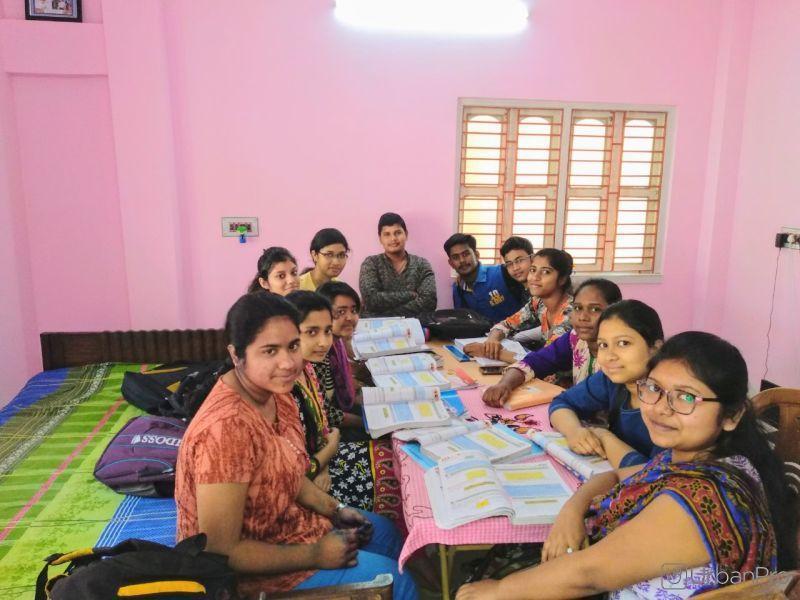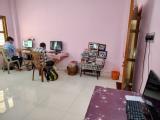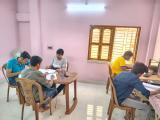
Birati, Kolkata, India - 700051.
Verified
79
Details verified of Amitava Majumder✕
 Identity
Identity
 Education
Education
Know how UrbanPro verifies Tutor details
Identity is verified based on matching the details uploaded by the Tutor with government databases.







Hindi
Bengali
English
![]() Sathyabama Institute of Science and Technology (Deemed University), Chennai 2006
Sathyabama Institute of Science and Technology (Deemed University), Chennai 2006
Bachelor of Engineering (B.E.)
Birati, Kolkata, India - 700051
![]() ID Verified
ID Verified
![]() Education Verified
Education Verified
![]() Phone Verified
Phone Verified
![]() Email Verified
Email Verified
![]() Facebook Verified
Facebook Verified
A
Aditya Academy
Dum Dum, Kolkata
S
St.xavier's school sodepur
Sodepur, North 24 Parganas
A
Assembly of God Church
Park Street, Kolkata
K
Kendriya Vidyalaya Ordnance Factory
Dumdum, Kolkata
A
Auxilium convent school
Dum Dum, Kolkata
A
Aditya Academy
Barasat H Q, Kolkata
B
Bharatiya Vidya Bhavan
Sector - 1, Kolkata
S
ST.Stephens School
Jessore Road, Kolkata
H
Hariyana Vidya Mandir
Salt Lake City, Kolkata
G
GD Birla School
Ranikuthi, Kolkata
D
Delhi Public School
New Town, Kolkata
S
St. Jude's High School madhyamgram
Madhyamgram, Kolkata
S
Sudhir memorial school
Madhyamgram Kora, Kolkata
A
Adamas International School
B T Road, Kolkata
S
St.stephen school
Birati, Kolkata
C
Central Modern School
BARASAT, Kolkata
Report this Profile
Is this listing inaccurate or duplicate? Any other problem?
Please tell us about the problem and we will fix it.
Class Location
![]() Online (video chat via skype, google hangout etc)
Online (video chat via skype, google hangout etc)
![]() Student's Home
Student's Home
![]() Tutor's Home
Tutor's Home
Years of Experience in C Language Classes
10
Class Location
![]() Online (video chat via skype, google hangout etc)
Online (video chat via skype, google hangout etc)
![]() Student's Home
Student's Home
![]() Tutor's Home
Tutor's Home
Years of Experience in C++ Language Classes
10
Proficiency level taught
Basic C++, Advanced C++
Class Location
![]() Online (video chat via skype, google hangout etc)
Online (video chat via skype, google hangout etc)
![]() Student's Home
Student's Home
![]() Tutor's Home
Tutor's Home
Years of Experience in Database Training classes
12
Class Location
![]() Online (video chat via skype, google hangout etc)
Online (video chat via skype, google hangout etc)
![]() Student's Home
Student's Home
![]() Tutor's Home
Tutor's Home
Years of Experience in Class 9 Tuition
10
Board
CBSE, IGCSE, ICSE, International Baccalaureate
Preferred class strength
Group Classes, One on one/ Private Tutions
Experience in School or College
12 year
Subjects taught
Information Technology, Information and Comunication Technology, Computers, Computer Practices, Computer Application
Taught in School or College
Yes
Teaching Experience in detail in Class 9 Tuition
When teaching Class 9 computer science tuition, I focus on delivering comprehensive and interactive learning experiences. My approach includes breaking down complex concepts such as fundamentals of computing, programming basics (often starting with languages like Python or Scratch)
Class Location
![]() Online (video chat via skype, google hangout etc)
Online (video chat via skype, google hangout etc)
![]() Student's Home
Student's Home
![]() Tutor's Home
Tutor's Home
Years of Experience in Class 10 Tuition
8
Board
CBSE, IGCSE, ICSE, International Baccalaureate
Preferred class strength
Group Classes, One on one/ Private Tutions
Subjects taught
Information Technology, Information and Comunication Technology, Computers, Computer Practices, Computer Application
Taught in School or College
No
Class Location
![]() Online (video chat via skype, google hangout etc)
Online (video chat via skype, google hangout etc)
![]() Student's Home
Student's Home
![]() Tutor's Home
Tutor's Home
Years of Experience in Class 11 Tuition
8
Board
ISC/ICSE, CBSE, IGCSE, State
Preferred class strength
Group Classes, One on one/ Private Tutions
Subjects taught
Computer Science
Taught in School or College
No
Class Location
![]() Online (video chat via skype, google hangout etc)
Online (video chat via skype, google hangout etc)
![]() Student's Home
Student's Home
![]() Tutor's Home
Tutor's Home
Years of Experience in Class 12 Tuition
10
Board
ISC/ICSE, CBSE, IGCSE, State
Preferred class strength
Group Classes, One on one/ Private Tutions
Subjects taught
Computer Science
Taught in School or College
No
Class Location
![]() Online (video chat via skype, google hangout etc)
Online (video chat via skype, google hangout etc)
![]() Student's Home
Student's Home
![]() Tutor's Home
Tutor's Home
Years of Experience in BCA Tuition
10
BCA Subject
Java Programming, Database Management Systems , Software Engineering , Data structures, Problem Solving and Programming , IT, Computer Basics and PC Software , Object Oriented Technologies, C Language Programming, Data and File Structures , Programming in C++
Type of class
Regular Classes
Class strength catered to
Group Classes, One on one/ Private Tutions
Taught in School or College
No
Class Location
![]() Online (video chat via skype, google hangout etc)
Online (video chat via skype, google hangout etc)
![]() Student's Home
Student's Home
![]() Tutor's Home
Tutor's Home
Years of Experience in BTech Tuition
10
BTech Computer Science subjects
Types of Database Systems, Object Oriented Programming & Systems, Java Programming, Data Structures and Algorithms, Object Technology, Database Management Systems, Internet Technology and Applications
BTech Branch
BTech Information Science Engineering, BTech Computer Science Engineering
BTech Information Science subjects
Operations and Systems Management, Design and Development of Web Applications, Operating Systems, Database Systems, Object Oriented Programming, Business Intelligence, Data Structures and Algorithms, Digital Systems
BTech Instrumentation subjects
Object Oriented Programming
Type of class
Regular Classes, Crash Course
Class strength catered to
One on one/ Private Tutions
Taught in School or College
No
Class Location
![]() Online (video chat via skype, google hangout etc)
Online (video chat via skype, google hangout etc)
![]() Student's Home
Student's Home
![]() Tutor's Home
Tutor's Home
Years of Experience in Python Training classes
10
Course Duration provided
3-6 months
Seeker background catered to
Individual, Corporate company, Educational Institution
Certification provided
No
Python applications taught
Web Scraping with Python , Machine Learning with Python, Data Analysis with Python , Web Development with Python , Regular Expressions with Python , Data Visualization with Python, Help in assignment, Data Science with Python, Data Extraction with Python
Teaching Experience in detail in Python Training classes
A typical Python training course would start by introducing the basics of the language, such as variables, data types, and control flow structures. The course would cover the syntax and semantics of the language, and how to write basic Python programs. After covering the basics, the course would move on to more advanced topics, such as functions, modules, and packages. The course would teach how to organize Python code into reusable modules and packages, and how to write functions to perform specific tasks. Another important topic in a Python training course would be object-oriented programming (OOP). The course would teach the principles of OOP and how to write classes and objects in Python. The course would also cover topics such as file input/output, regular expressions, and exception handling. These topics are important for working with files, parsing data, and handling errors in Python programs. Finally, the course would cover popular Python libraries such as NumPy, Pandas, and Matplotlib. These libraries are used for data analysis and visualization in Python, and are essential tools for many Python developers. Throughout the course, students would have the opportunity to work on exercises and projects to reinforce their learning. The course would also provide resources for students to continue learning and practicing Python after the course is completed.
5.0 out of 5 43 reviews
Sambhavi Bhattacharjee
Class 12 Tuition Board of Education:CBSE Preferred class strength:One on one/ Private Tutions CBSE Subject:Computer Science
"Really good, sir is really polite and patience and he knows how to tutor any type of students he will clear the concept really well. "
Srijan Roy
BTech Tuition BTech Branch:BTech Computer Science Engineering BTech Computer Science subjects:Artificial Intelligence,Big Data Analytics,Computer Networks,Data Structures and Algorithms,Database Management Systems,Natural Language Processing,Object Oriented Programming & Systems
"Attending tuition from my computer teacher has been an incredible experience. Sir's teaching style is not only clear and engaging but also tailored to ensure every student understands the concepts thoroughly. His dedication and passion for teaching are evident in the way he patiently explains even the smallest details, making complex topics seem simple. "
Anusmita Shome
Class 12 Tuition Board of Education:ISC/ICSE Subject:Computer Science
"He is a great teacher and mentor. His patience, guidance, and encouragement have made a profound impact on my learning journey. His ability to break down complex concepts into simple, understandable pieces is truly helpful. "
Souhardya Chakraborty
Class 12 Tuition
"He's an outstanding teacher to say the least . If somebody doesn't likes computer programming he makes it sure that the student starts falling in love with coding. "
1. Which classes do you teach?
I teach BCA Tuition, BTech Tuition, C Language, C++ Language, Class 10 Tuition, Class 11 Tuition, Class 12 Tuition, Class 9 Tuition, Database Training and Python Training Classes.
2. Do you provide a demo class?
No, I don't provide a demo class.
3. How many years of experience do you have?
I have been teaching for 10 years.
What is WorkTable in SQL Server? USE AdventureWorks2014 GO SET STATISTICS IO ON GO SELECT * FROM Production.Product p CROSS JOIN Production.Product p1 GO If you run above query,...
Rename the logical name of SQL Server database files using T-SQL: 1. Problem: SQL Server database files have two names: one is the logical file name and the other is the physical file name. The logical...
SQL SERVER: How To Pass Parameters To The Stored Procedure? After so many years of existence of the stored procedures, I still see developers struggling to execute the stored procedure. The most common...
Answered on 04 Feb Learn IT Courses/Programming Languages/Python
Answered on 26 Jan Learn IT Courses/Programming Languages/Python
Answered on 10/05/2019 Learn IT Courses/Programming Languages/C Language
Following is the basic structure of a C program.
Documentation Consists of comments, some description of the program, programmer name and any other useful points that can be referenced later.
Link Provides instruction to the compiler to link function from the library function.
Definition Consists of symbolic constants.
Global declaration Consists of function declaration and global variables.
main( )
{
} Every C program must have a main() function which is the starting point of the program execution.
Subprograms User defined functions.
Lets explore the sections with an example.
Write a program to print area of a circle.
In the following example we will find the area of a circle for a given radius 10cm.
Formula
The formula to compute the area of a circle is πr2 where π is PI = 3.1416 (approx.) and r is the radius of the circle.
Lets write the C code to compute the area of the circle.
#include <stdio.h>
#define PI 3.1416
float area(float r);
int main(void)
{
float r = 10;
printf("Area: %.2f", area(r));
return 0;
}
float area(float r) {
return PI * r * r;
}
The above code will give the following output.
Area: 314.16
Different sections of the above code
Documentation
This section contains a multi line comment describing the code.
In C, we can create single line comment using two forward slash // and we can create multi line comment using /* */.
Comments are ignored by the compiler and is used to write notes and document code.
Link
This section includes header file.
#include <stdio.h>
We are including the stdio.h input/output header file from the C library.
Definition
This section contains constant.
#define PI 3.1416
In the above code we have created a constant PI and assigned 3.1416 to it.
The #define is a preprocessor compiler directive which is used to create constants. We generally use uppercase letters to create constants.
The #define is not a statement and must not end with a ; semicolon.
Global declaration
This section contains function declaration.
float area(float r);
We have declared an area function which takes a floating number (i.e., number with decimal parts) as argument and returns floating number.
main( ) function
This section contains the main() function.
int main(void)
{
float r = 10;
printf("Area: %.2f", area(r));
return 0;
}
This is the main() function of the code. Inside this function we have created a floating variable r and assigned 10 to it.
Then we have called the printf() function. The first argument contains "Area: %.2f" which means we will print floating number having only 2 decimal place. In the second argument we are calling the area() function and passing the value of r to it.
Subprograms
This section contains a subprogram, an area() function that is called from the main() function.
float area(float r) {
return PI * r * r;
}
This is the definition of the area() function. It receives the value of radius in variable r and then returns the area of the circle using the following formula PI * r * r.
The math.h header defines various mathematical functions and one macro. All the functions available in this library take double as an argument and return double as the result.
string.h is the header in the C standard library for the C programming language which contains macro definitions, constants and declarations of functions and types used not only for string handling but also various memory handling functions;
Answered on 19/08/2017 Learn IT Courses/SQL Programming
Answered on 31/07/2017 Learn IT Courses/SQL Programming
Class Location
![]() Online (video chat via skype, google hangout etc)
Online (video chat via skype, google hangout etc)
![]() Student's Home
Student's Home
![]() Tutor's Home
Tutor's Home
Years of Experience in C Language Classes
10
Class Location
![]() Online (video chat via skype, google hangout etc)
Online (video chat via skype, google hangout etc)
![]() Student's Home
Student's Home
![]() Tutor's Home
Tutor's Home
Years of Experience in C++ Language Classes
10
Proficiency level taught
Basic C++, Advanced C++
Class Location
![]() Online (video chat via skype, google hangout etc)
Online (video chat via skype, google hangout etc)
![]() Student's Home
Student's Home
![]() Tutor's Home
Tutor's Home
Years of Experience in Database Training classes
12
Class Location
![]() Online (video chat via skype, google hangout etc)
Online (video chat via skype, google hangout etc)
![]() Student's Home
Student's Home
![]() Tutor's Home
Tutor's Home
Years of Experience in Class 9 Tuition
10
Board
CBSE, IGCSE, ICSE, International Baccalaureate
Preferred class strength
Group Classes, One on one/ Private Tutions
Experience in School or College
12 year
Subjects taught
Information Technology, Information and Comunication Technology, Computers, Computer Practices, Computer Application
Taught in School or College
Yes
Teaching Experience in detail in Class 9 Tuition
When teaching Class 9 computer science tuition, I focus on delivering comprehensive and interactive learning experiences. My approach includes breaking down complex concepts such as fundamentals of computing, programming basics (often starting with languages like Python or Scratch)
Class Location
![]() Online (video chat via skype, google hangout etc)
Online (video chat via skype, google hangout etc)
![]() Student's Home
Student's Home
![]() Tutor's Home
Tutor's Home
Years of Experience in Class 10 Tuition
8
Board
CBSE, IGCSE, ICSE, International Baccalaureate
Preferred class strength
Group Classes, One on one/ Private Tutions
Subjects taught
Information Technology, Information and Comunication Technology, Computers, Computer Practices, Computer Application
Taught in School or College
No
Class Location
![]() Online (video chat via skype, google hangout etc)
Online (video chat via skype, google hangout etc)
![]() Student's Home
Student's Home
![]() Tutor's Home
Tutor's Home
Years of Experience in Class 11 Tuition
8
Board
ISC/ICSE, CBSE, IGCSE, State
Preferred class strength
Group Classes, One on one/ Private Tutions
Subjects taught
Computer Science
Taught in School or College
No
Class Location
![]() Online (video chat via skype, google hangout etc)
Online (video chat via skype, google hangout etc)
![]() Student's Home
Student's Home
![]() Tutor's Home
Tutor's Home
Years of Experience in Class 12 Tuition
10
Board
ISC/ICSE, CBSE, IGCSE, State
Preferred class strength
Group Classes, One on one/ Private Tutions
Subjects taught
Computer Science
Taught in School or College
No
Class Location
![]() Online (video chat via skype, google hangout etc)
Online (video chat via skype, google hangout etc)
![]() Student's Home
Student's Home
![]() Tutor's Home
Tutor's Home
Years of Experience in BCA Tuition
10
BCA Subject
Java Programming, Database Management Systems , Software Engineering , Data structures, Problem Solving and Programming , IT, Computer Basics and PC Software , Object Oriented Technologies, C Language Programming, Data and File Structures , Programming in C++
Type of class
Regular Classes
Class strength catered to
Group Classes, One on one/ Private Tutions
Taught in School or College
No
Class Location
![]() Online (video chat via skype, google hangout etc)
Online (video chat via skype, google hangout etc)
![]() Student's Home
Student's Home
![]() Tutor's Home
Tutor's Home
Years of Experience in BTech Tuition
10
BTech Computer Science subjects
Types of Database Systems, Object Oriented Programming & Systems, Java Programming, Data Structures and Algorithms, Object Technology, Database Management Systems, Internet Technology and Applications
BTech Branch
BTech Information Science Engineering, BTech Computer Science Engineering
BTech Information Science subjects
Operations and Systems Management, Design and Development of Web Applications, Operating Systems, Database Systems, Object Oriented Programming, Business Intelligence, Data Structures and Algorithms, Digital Systems
BTech Instrumentation subjects
Object Oriented Programming
Type of class
Regular Classes, Crash Course
Class strength catered to
One on one/ Private Tutions
Taught in School or College
No
Class Location
![]() Online (video chat via skype, google hangout etc)
Online (video chat via skype, google hangout etc)
![]() Student's Home
Student's Home
![]() Tutor's Home
Tutor's Home
Years of Experience in Python Training classes
10
Course Duration provided
3-6 months
Seeker background catered to
Individual, Corporate company, Educational Institution
Certification provided
No
Python applications taught
Web Scraping with Python , Machine Learning with Python, Data Analysis with Python , Web Development with Python , Regular Expressions with Python , Data Visualization with Python, Help in assignment, Data Science with Python, Data Extraction with Python
Teaching Experience in detail in Python Training classes
A typical Python training course would start by introducing the basics of the language, such as variables, data types, and control flow structures. The course would cover the syntax and semantics of the language, and how to write basic Python programs. After covering the basics, the course would move on to more advanced topics, such as functions, modules, and packages. The course would teach how to organize Python code into reusable modules and packages, and how to write functions to perform specific tasks. Another important topic in a Python training course would be object-oriented programming (OOP). The course would teach the principles of OOP and how to write classes and objects in Python. The course would also cover topics such as file input/output, regular expressions, and exception handling. These topics are important for working with files, parsing data, and handling errors in Python programs. Finally, the course would cover popular Python libraries such as NumPy, Pandas, and Matplotlib. These libraries are used for data analysis and visualization in Python, and are essential tools for many Python developers. Throughout the course, students would have the opportunity to work on exercises and projects to reinforce their learning. The course would also provide resources for students to continue learning and practicing Python after the course is completed.
Answered on 04 Feb Learn IT Courses/Programming Languages/Python
Answered on 26 Jan Learn IT Courses/Programming Languages/Python
Answered on 10/05/2019 Learn IT Courses/Programming Languages/C Language
Following is the basic structure of a C program.
Documentation Consists of comments, some description of the program, programmer name and any other useful points that can be referenced later.
Link Provides instruction to the compiler to link function from the library function.
Definition Consists of symbolic constants.
Global declaration Consists of function declaration and global variables.
main( )
{
} Every C program must have a main() function which is the starting point of the program execution.
Subprograms User defined functions.
Lets explore the sections with an example.
Write a program to print area of a circle.
In the following example we will find the area of a circle for a given radius 10cm.
Formula
The formula to compute the area of a circle is πr2 where π is PI = 3.1416 (approx.) and r is the radius of the circle.
Lets write the C code to compute the area of the circle.
#include <stdio.h>
#define PI 3.1416
float area(float r);
int main(void)
{
float r = 10;
printf("Area: %.2f", area(r));
return 0;
}
float area(float r) {
return PI * r * r;
}
The above code will give the following output.
Area: 314.16
Different sections of the above code
Documentation
This section contains a multi line comment describing the code.
In C, we can create single line comment using two forward slash // and we can create multi line comment using /* */.
Comments are ignored by the compiler and is used to write notes and document code.
Link
This section includes header file.
#include <stdio.h>
We are including the stdio.h input/output header file from the C library.
Definition
This section contains constant.
#define PI 3.1416
In the above code we have created a constant PI and assigned 3.1416 to it.
The #define is a preprocessor compiler directive which is used to create constants. We generally use uppercase letters to create constants.
The #define is not a statement and must not end with a ; semicolon.
Global declaration
This section contains function declaration.
float area(float r);
We have declared an area function which takes a floating number (i.e., number with decimal parts) as argument and returns floating number.
main( ) function
This section contains the main() function.
int main(void)
{
float r = 10;
printf("Area: %.2f", area(r));
return 0;
}
This is the main() function of the code. Inside this function we have created a floating variable r and assigned 10 to it.
Then we have called the printf() function. The first argument contains "Area: %.2f" which means we will print floating number having only 2 decimal place. In the second argument we are calling the area() function and passing the value of r to it.
Subprograms
This section contains a subprogram, an area() function that is called from the main() function.
float area(float r) {
return PI * r * r;
}
This is the definition of the area() function. It receives the value of radius in variable r and then returns the area of the circle using the following formula PI * r * r.
The math.h header defines various mathematical functions and one macro. All the functions available in this library take double as an argument and return double as the result.
string.h is the header in the C standard library for the C programming language which contains macro definitions, constants and declarations of functions and types used not only for string handling but also various memory handling functions;
Answered on 19/08/2017 Learn IT Courses/SQL Programming
Answered on 31/07/2017 Learn IT Courses/SQL Programming
What is WorkTable in SQL Server? USE AdventureWorks2014 GO SET STATISTICS IO ON GO SELECT * FROM Production.Product p CROSS JOIN Production.Product p1 GO If you run above query,...
Rename the logical name of SQL Server database files using T-SQL: 1. Problem: SQL Server database files have two names: one is the logical file name and the other is the physical file name. The logical...
SQL SERVER: How To Pass Parameters To The Stored Procedure? After so many years of existence of the stored procedures, I still see developers struggling to execute the stored procedure. The most common...

Share this Profile
Also have a look at
Reply to 's review
Enter your reply*
Your reply has been successfully submitted.
Certified
The Certified badge indicates that the Tutor has received good amount of positive feedback from Students.